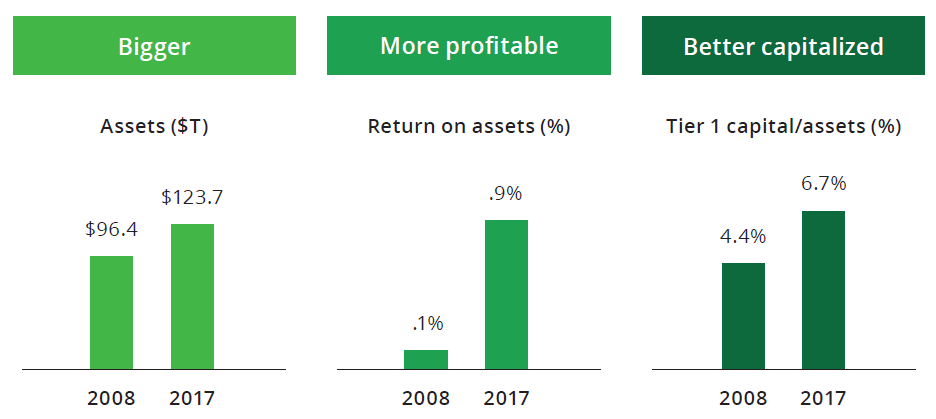
High-level takeaways
- Return on Equity (ROE) for Western banks is up to 8.6% in 2017, up from 5.5%.
- The top 4 largest banks in the world in 2019 are Chinese. This surprised me so much, I had to corroborate with another source here.
- Banks have been too timid to change. Deloitte say that “change the the bank” initiatives should take center stage, and become the new operating models to “run the bank.” Big talk.
- Technology is everywhere. AI, blockchain, cloud, etc. . .but banks should give up the “grand visions of becoming tech companies,” and instead, become better banks.
What are the buckets?
Consultants are supremely good at logically thinking through problems and putting things into buckets. It helps to organize the information, emphasize the most important parts, and tell compelling stories. Here’s one graphical way to show a lot of qualitative information. Categorization can be storytelling.
Fishbone (Ishikawa) Diagram
For those unfamiliar with this tool, it’s a simple way to organize buckets of cause / effect. It looks like a fishbone skeleton with the different causes as the big bones, and supporting categories as the smaller bones. On the right, the fish-head is the effect you are explaining.
It’s an outline, laying on it’s side.
If I were to say that banking and capital markets are changing a lot (effect), you might ask, “How?” Rather that just listing 100+ different bullets and data points, it’s smart to organize the content. Deloitte listed 10 different areas, and I teased out another two from the write up (Talent, MA) to make 12 key causes of changes in the banking industry.
Caveat: this is not a purist approach. The different causes are not MECE (mutually exclusive and collectively exhaustive). You can see that four are support functions (regulatory, risk, technology, talent), while another 4 are business lines (corporate, transaction, retail, investment).
Yes, this creates overlap.
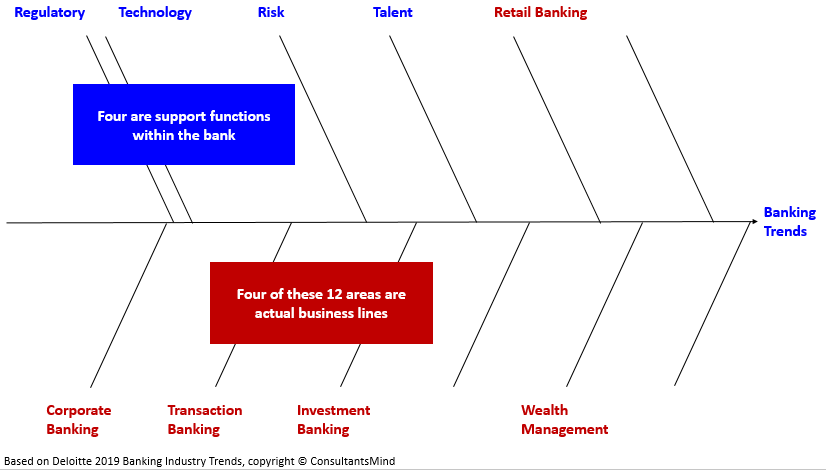
Given a choice, you’d want this to be more mutually exclusive, so there is limited overlap. Given a choice, you’d have less than 12 categories, because you are trying to tell a prioritized, specific story. Given a choice, you’d never present this to an executive because it looks like a shot-gun spray of words.
However, this is an industry report with lots of trends and great things to know. This is not meant to persuade, dissuade, or build an argument. This is mean to inform. So, please take it with a grain of non-MECE salt and enjoy. Here is how I thought about the 13,000+ word Deloitte report.
First 6 drivers of banking change
- Regulatory – Really varies by country. Less of a global approach to finance.
- Technology – Massive topic, but essentially 3 big buckets: data, infrastructure, and AI.
- Risk – 2 types. Legacy, and emerging (driven by prevalence and complexity of algorithms).
- Corporate banking – Easy operating environment (low rates, loose regulation), so banks need to take this opportunity to modernize all parts of their operations.
- Transaction banking – This part of the report was light, but block chain seems to be the potential game-changer with a distributed ledger to tract asset ownership.
- Investment banking – Advisory doing well; US has been the big winner (58% market share in 2017, up from 49% in 2010). Lots of AI in trading. AllianceBerstein’s Abbie algorithm handles 35% of bond trades. Yes, the machines are coming to banking too.
Next 6 drivers of banking change
- Talent – Adaptable, AI-conversant, generalists who can augment / complement AI.
- Retail banking – Huge street fight among incumbents, start-ups, and tech giants.
- M&A – M&A will continue as banks look to bulk up for economies of scale. Higher SIFI threshold ($250B) in Nov 2019, allows < $250B asset banks to benefit from lighter regulation.
- Payments – In my mind, there is the existing payment value chain (First Data, Ingenico, Tysys, Visa, Mastercard, American Express) in the US. Then there is the emerging peer-to-peer (P2P) technologies like (TenPay, AliPay, PayTM) in China and India.
- Wealth management – lots of talk of robo-advisers, but the bigger stories is the increasing shift of Ultra HNW, and High net worth to Asia. Unmentioned, was the rise of private offices.
- Market infrastructure – M&A of exchanges and clearing houses. The electronification (vs. phone calls between sales/trading desks) for corporate bonds seems like a big deal.
Click on the Fishbone diagram for closer look
What other ways to divvy up the topics?
This is just one way to slice/dice the content of For those new to banking (or planning to interview) this 40pg Deloitte report is worth your read here (2.4Mb, 40pg). For those in finance and those who keep up with global banking trends, what do you think is missing from this report? Perhaps we should layer on our point-of-view on to this fishbone. . .
Related posts:

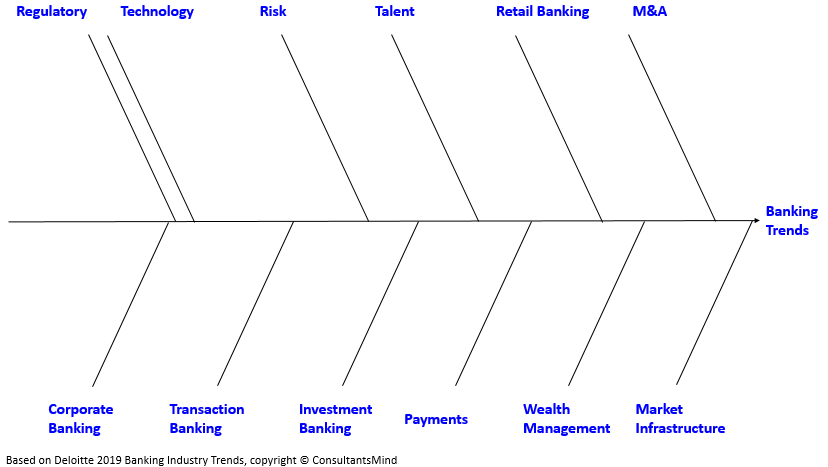
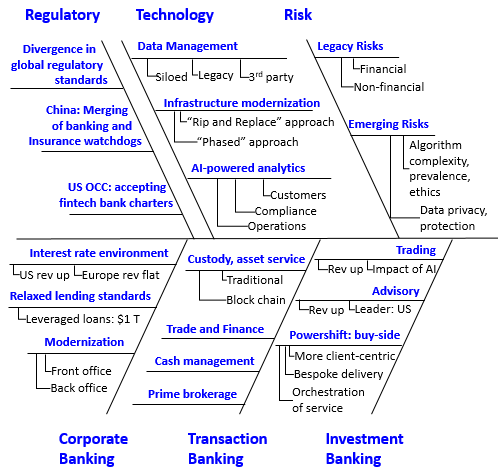
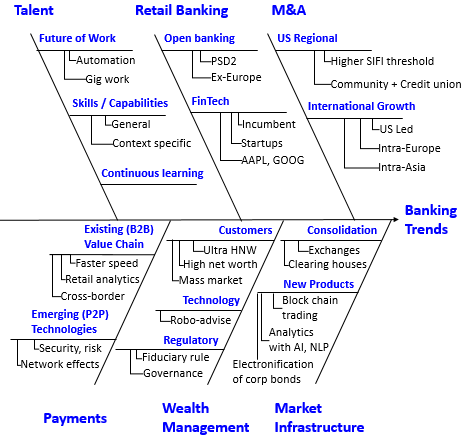
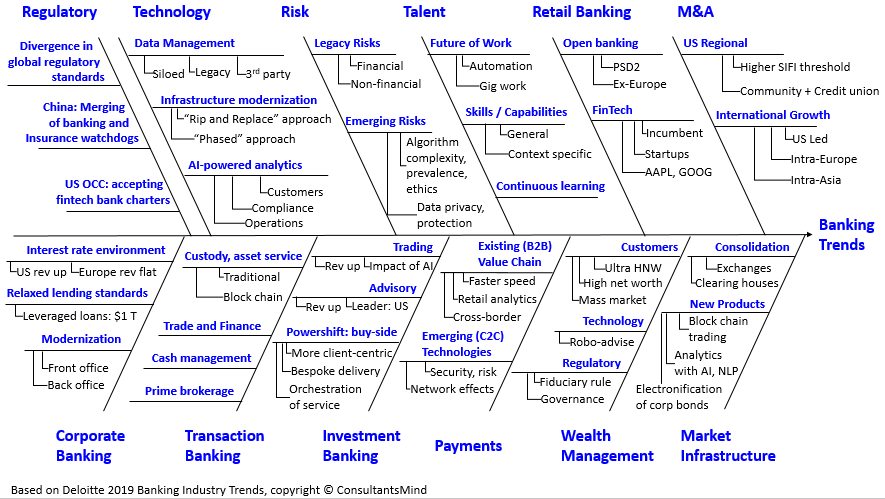
I’ve been in cap mkts for >20-yrs. This is an excellent summary of what’s been happening since the 2008 financial crisis.
Great work, John – thanks for sharing
Danny – thanks for reading. After 20+ years, would you agree that more is changing now (and faster) than ever before? Net/net great time to be a smart, flexible, learning person in finance. .
Thanks for the enlightening report. I have always been interested in the banking sector, since my days in risk management. Fascinating stories of survival, deep state-like secrets of the trade. What’s interesting to note is your commentary about banks being just better banks. The phenomenon has been consistent with the majors that favored investment banking, corporate units, splashed them with outrageous bonuses and commission structures. They even forgot to be a customer-centric bank. What comes to mind is Tidjane Thiam of Credit Swisse and how his restructuring approach seems like a playbook for others ( similary more levered giants) to follow- His message was as simple as you indicated, go back to basics, cut down on loss making units, take care of private wealth customers and if retail is a huge driver, make retail more nimble, agile, and boost your CRM strategy to retain ever more tech-savvy banking customers.
Hello Adi, thank you for the comment. Like that. . really back-to-basics, of customer services. Doesn’t matter is the customers are pensions, governments, private offices, CFO, or your grandma. . .just be a better bank. Winning.